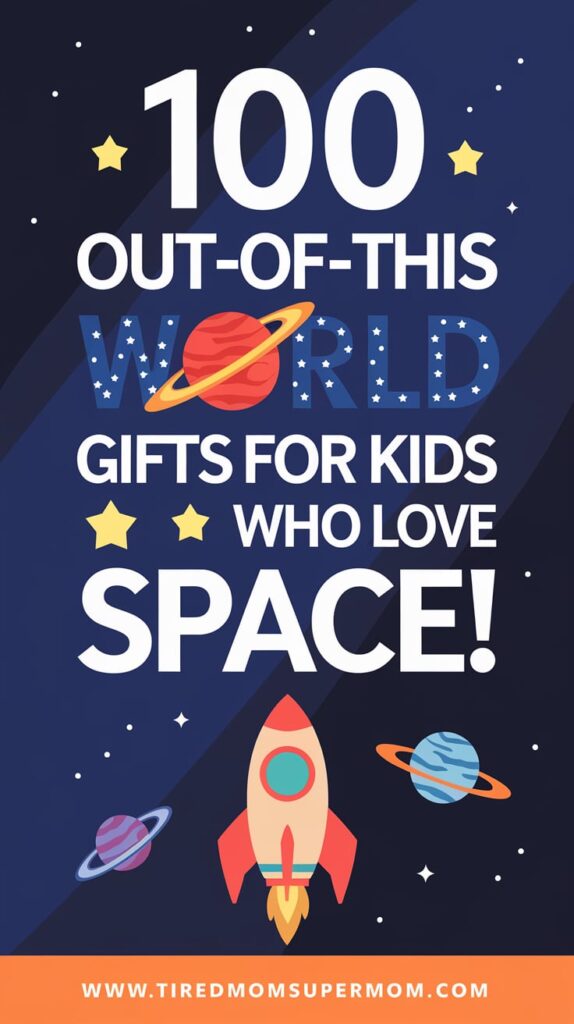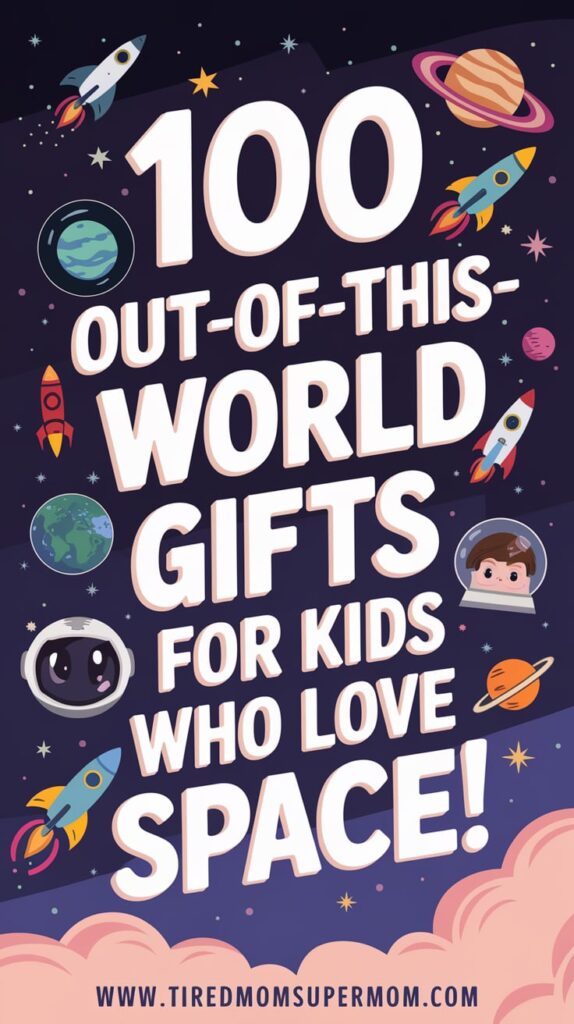100 Best Space Gifts for Kids Who Love the Galaxy
Kids don’t just go through a “space phase.” Some of them live it—breathing galaxies, whispering rocket facts at breakfast, and asking wildly specific questions about Saturn’s rings while you’re trying to unload the dishwasher.
These are the kids who look up and genuinely expect magic to happen. And honestly? They’re not wrong. Space is magic. It’s wonder packaged in stardust, math, and mystery, and it gives kids permission to think bigger than the world right in front of them.
Heads up: This post may include affiliate links. As an Amazon Associate, I earn from qualifying purchases—at no extra cost to you. Full privacy policy and disclosure here.
Space Gifts for Young Explorers (Ages 3–5)
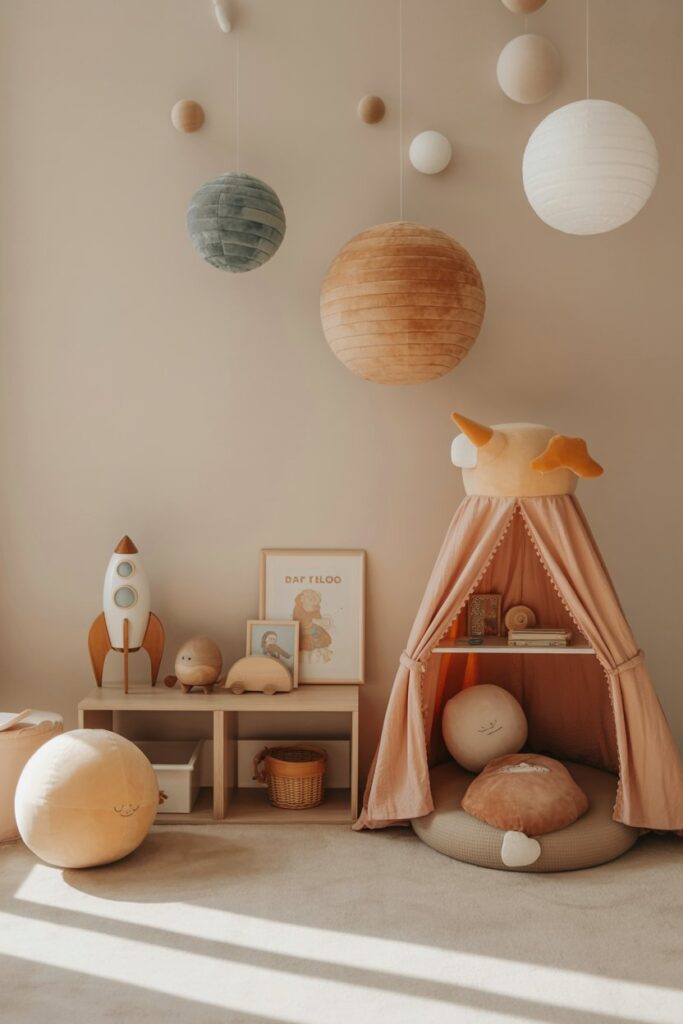
There’s something uniquely tender about the way little kids experience space. They don’t think about galaxies and planets the way adults do — they feel them. To a preschooler, the moon is a friend who follows them home, and a rocket ship is less a machine and more a promise that the world is bigger than they realized yesterday. At this age, the right space gifts don’t just entertain; they become anchors for wonder, comfort, and connection.
Plush planets and soft astronaut dolls make the cosmos feel safe and familiar — the kind of companions kids fold into bedtime routines without even thinking. A set of cuddly planets turns the solar system into something they can hold close, which is often exactly what early learners need.
For little hands eager to make sense of their world, chunky solar system puzzles offer calm, confidence-building moments. The pieces are big and satisfying to grasp, the colors gentle but bright. (Amazon: solar system puzzles)
Bedtime often becomes its own sensory experience at this age, and glow-in-the-dark stars can soften that transition. A ceiling constellation turns an ordinary room into a little universe — quietly reassuring, a bit magical, and perfect for kids who need a visual cue that nighttime doesn’t have to feel lonely. (shop stars)
Simple space-themed picture books give kids a language for their wonder. These stories weave early science with emotional safety, helping them understand new ideas without overwhelming their still-soft minds.
Some kids process the world through touch, movement, and mess — and that’s where wooden rocket stackers and toddler-safe moon sand shine. You can make an edible “moon surface” using a basic sensory-dough recipe from a trusted source like AllRecipes, giving them space (literally) to squish, shape, and explore. These moments matter more than they seem; they’re tiny rehearsals for curiosity.
And for the kids who live in a world powered by imagination? A lightweight astronaut helmet is often all they need. One moment they’re in your living room; the next, they’re on the moon, telling you what the craters look like up close. It’s pretend play with a heartbeat — the kind that builds confidence one mission at a time.
STEM-Forward Space Gifts (Ages 6–9)
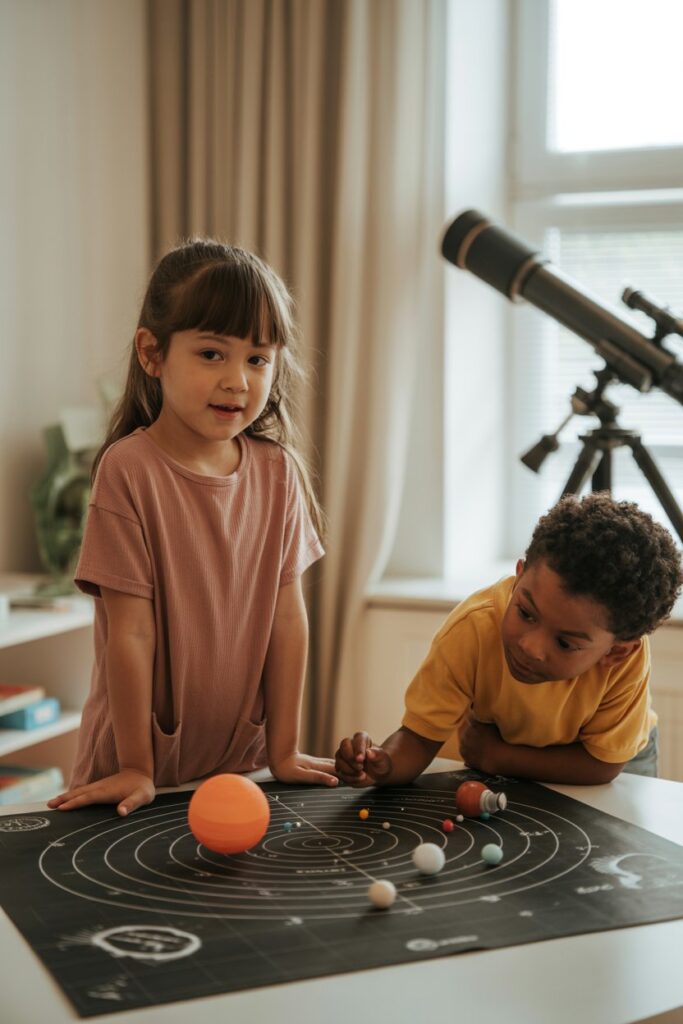
Something shifts around age six. Kids start asking bigger questions — the kind that make you pause mid-laundry and think, Wow, you’ve been paying attention. Space suddenly becomes less about pretend play and more about patterns, cause-and-effect, and the thrill of figuring things out themselves. These STEM-forward space gifts meet them right in that sweet spot, where curiosity and capability begin to overlap.
Hands-on learners will gravitate toward build-your-own solar system kits, where the reward isn’t just the finished project but the quiet, focused moments in between. Kids this age crave independence, and these kits give them exactly that — with just enough guidance to keep frustration low.
A beginner telescope is another magical option. It doesn’t need to be high-tech to feel transformative. Even a kid-friendly model from Amazon (shop beginner telescopes) can make your backyard feel like a gateway to something bigger. The first time they spot the moon’s craters on their own? That moment stays with them.
For kids who love a little mess, space slime and science kits bring the wonder down to their fingertips. Thick, stretchy, glittery “galaxy slime” taps into that deeply satisfying sensory experience while teaching basic chemistry in a way that feels like play, not homework.
A DIY constellation projector is another beautiful bridge between imagination and science. It lets kids build something with their hands, then watch their work turn into a night-sky display on their bedroom ceiling — a moment of self-created magic that feels almost sacred at this age.
And because kids are natural pattern seekers, magnetic star charts and early coding games help them make sense of systems: how planets move, how stars shift, how sequences create outcomes. It’s the gentle beginning of critical thinking wrapped in something sparkly and fun.
For a cozy, on-theme baking moment, consider making “galaxy popcorn” together — simply swirling colored sugar over fresh popcorn using inspiration from sites like Taste of Home. It’s hands-on, sensory-rich, and just messy enough to feel like an adventure.
Gifts for Serious Space Fans (Ages 10–12)
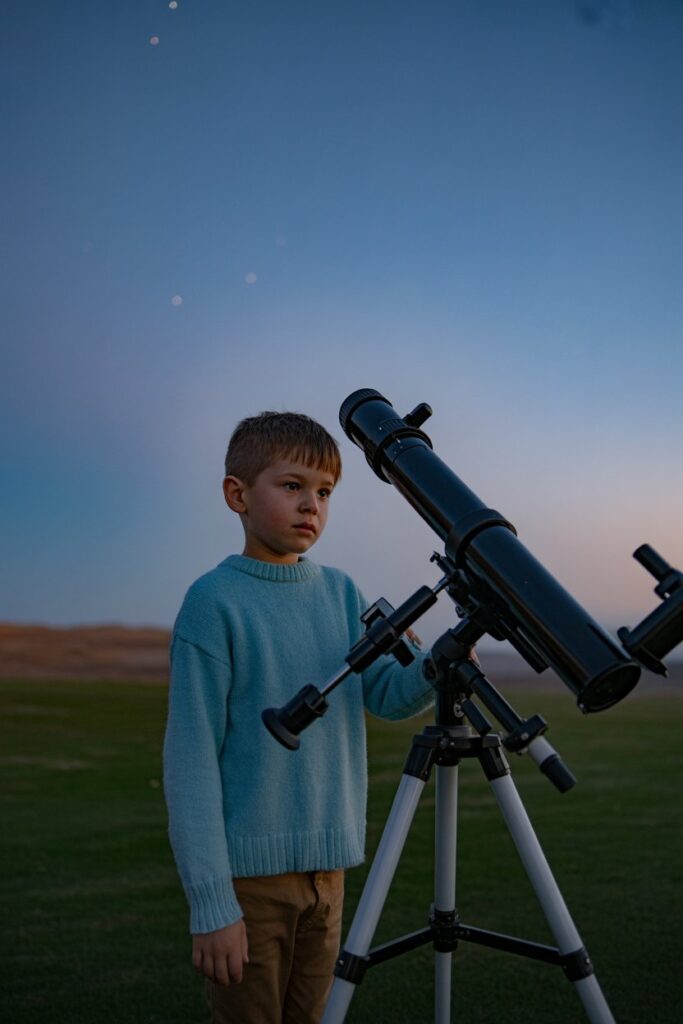
By the time kids hit the 10–12 window, their relationship with space becomes wonderfully specific. They don’t just “like” the stars — they can tell you which ones are visible in winter, why rockets need boosters, and what NASA is planning next. These are the kids who’ve crossed over from fascination to dedication, and the gifts that speak to them are the ones that honor that growing sense of identity.
Advanced STEM kits are a standout here. These are the kits that ask kids to follow multi-step instructions, troubleshoot, and stay focused long enough to feel the pride that comes from real accomplishment. Whether they’re assembling a miniature Mars rover or wiring a simple circuit board, these projects meet them at their new level of capability.
If your child has ever lingered outside just a little longer to “see if the moon looks different tonight,” a more grown-up telescope can be a deeply meaningful upgrade. You don’t have to splurge on something professional — even mid-range models on Amazon (browse beginner astronomy telescopes) offer crisp views that transform backyard stargazing into a real skill.
For kids drawn to building and engineering, model rockets and simple launch kits provide a thrill that borders on life-changing. There’s nothing quite like watching something you built lift off the ground, even if it’s only a few feet. These moments plant seeds — little sparks that can bloom into lifelong passions.
Star-mapping journals give kids a quieter way to connect with the sky. They’re perfect for anyone who likes to sketch, track patterns, or record what they notice night by night. There’s a grounding calm to this ritual, one that helps kids feel both small and expansive all at once.
Some kids are ready for a bit more tech, and that’s where intro-to-astrophotography kits shine. These beginner-friendly sets allow them to attach a simple camera or smartphone to a telescope and capture what they see — a modern kind of magic that bridges creativity, science, and a growing sense of autonomy.
And because tweens still love a good treat, you can pair a building session or stargazing night with a simple cosmic-themed dessert. A rich, swirl-topped brownie — inspired by recipes from AllRecipes — becomes a little edible celebration of everything they’re learning and becoming.
Space Gifts for Teens Who Still Love the Stars (Ages 13+)

There’s something quietly powerful about a teen who still looks up. They’ve outgrown the toy phase, but not the wonder — and that in-between space is where the most meaningful gifts live. These space-inspired picks respect who they’re becoming: more independent, more thoughtful, more aware of the world and their place in it. They’re not “kid gifts” anymore; they’re tools, comforts, and creative outlets that align with a deeper kind of curiosity.
For teens who lean into tech, coding-driven robotics kits offer that perfect balance of challenge and possibility. They tap into the kind of problem-solving that teens are naturally good at — tinkering, testing, adjusting — without feeling like homework. It’s where creativity meets competence, and teens thrive in that space.
Galaxy projectors and LED space décor satisfy the desire to create a room that feels like theirs. These gifts don’t just decorate; they reshape a space into something calming, personal, and distinctly atmospheric. A neon Saturn sign or soft star-scape projection can turn a bedroom into a sanctuary — a place to unwind, think, or dream about futures that stretch beyond the horizon.
Art-driven teens may gravitate toward high-quality lunar prints or constellation posters — pieces that feel modern and a little moody, the kind of décor that grows with them into adulthood. Many of these options on Amazon are surprisingly affordable (shop lunar art) while still feeling gallery-ready.
If your teen still loves a challenge, 1000-piece galaxy puzzles can be strangely grounding. There’s a rhythm to puzzling that teens crave — something quiet but absorbing, a task that gives their busy minds a place to land.
For the ones who devour knowledge, space science books written for young adults make incredible gifts. Whether they’re diving into black hole theory, planetary geology, or stories from NASA missions, these books widen their perspective in ways that matter.
And because teens still appreciate a practical gift, space-themed wearables — like sleek NASA hoodies or constellation embroidered caps — give them a way to express who they are without saying a word. (Amazon: NASA apparel)
If you want to make the moment feel special, pair one of these gifts with a low-effort treat, like a batch of simple swirl cookies inspired by recipes on Food Network. Teens pretend they don’t care, but small gestures still land quietly and deeply.
Space Clothing + Wearable Accessories

Clothing is one of the first ways kids learn to express themselves. Long before they can articulate what they’re feeling, they choose the shirt with the rocket on it or the socks with tiny galaxies because something about it feels like them. Space-themed wearables offer kids a way to carry their curiosity out into the world — literally wrapped around their shoulders.
NASA hoodies and tees have a quiet confidence to them. They’re soft, unfussy, and instantly recognizable — a little badge of belonging for kids who love science, exploration, or simply the idea of reaching beyond what’s familiar. Many options on Amazon (browse NASA apparel) are cozy enough for everyday wear while still feeling special.
For kids who love comfort first, star-print pajamas and galaxy sleep sets transform bedtime into something calmer and dreamier. These are the pajamas that get worn on repeat — the ones that make nighttime feel less like a task and more like a soft landing.
Some kids want a touch of magic without announcing it to the world. Glow-in-the-dark socks are perfect for that quieter personality — a tiny secret constellation they get to carry around during the day, only revealing itself when the lights turn low.
For kids with big style energy, space dresses and galaxy skirts let them show up boldly. These pieces move beautifully, catching light in all the right ways, and they often become “favorite outfit” material — the kind they reach for when they want to feel brave or joyful or fully themselves.
School-age kids will get tons of use out of constellation backpacks and lunchboxes. These practical pieces become little portals to imagination during everyday routines, turning even the walk to school into a mini adventure. (Amazon: shop space backpacks)
And for the kids who love a finishing touch? Space-themed hats, scrunchies, and enamel pins add personality without effort. They’re small, meaningful, and perfect for kids who like quiet flair — that subtle nod to something they love.
Pretend Play + Imaginative Gifts
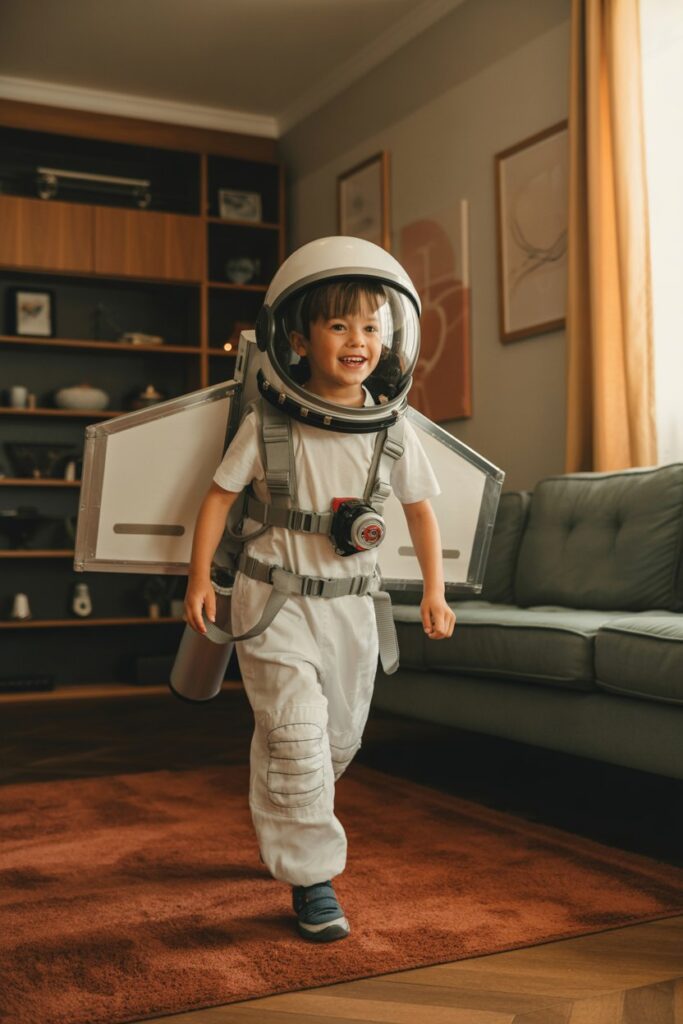
Pretend play is where childhood expands. It’s where a cardboard box becomes a rocket, a blanket becomes a launchpad, and the living room transforms into a corner of the cosmos. For so many kids, imagination is their first language — and space-themed pretend play gifts give them the tools to tell bigger, braver stories about who they are and what they dream of becoming.
Astronaut helmets and soft jetpacks are instant confidence-boosters. These aren’t just costumes; they’re invitations. The moment kids slip them on, their posture changes, their voice lifts, and suddenly they’re announcing a mission briefing from the hallway. Lightweight designs from Amazon (shop astronaut helmets) make it easy for kids to move, run, and imagine freely.
For families who love a good rainy-day activity, cardboard rocket kits are equal parts creative project and dramatic-play goldmine. Kids get to build, decorate, and eventually climb inside their creation — a full sensory loop that supports independence and imagination in the sweetest ways.
Playsets featuring space missions, rovers, and friendly aliens offer structure without limiting creativity. They give kids characters and pieces to start with, but the stories that unfold? Those belong entirely to them. Many of these sets end up becoming comfort toys — the ones that live in backpacks, car seats, and bedside baskets.
If your child is big on process play, DIY rocket-building kits give them a project that feels important. There’s something powerful about watching kids connect pieces, tighten tiny screws, and proudly announce, “I built this myself.” It’s a small achievement with a big emotional ripple.
For softer, sillier moments, alien plushies hit that sweet spot between odd and adorable. They’re quirky enough to spark storytelling, but still warm and comforting — a perfect companion for kids who like their adventures a little whimsical.
If you prefer gifts with a smaller footprint, pretend-play control panels offer big imagination in a contained package. Kids can tap buttons, “radio” mission control, and narrate entire space journeys without leaving the playroom. It’s make-believe play with just enough structure to keep things engaging.
And if you want an option with a feel-good angle, many brands now offer eco-friendly or ethically made imaginative play toys — a natural place to link to your Socially Conscious Gifts for Kids guide for families who prioritize meaningful sourcing.
Educational Space Books + Storybooks
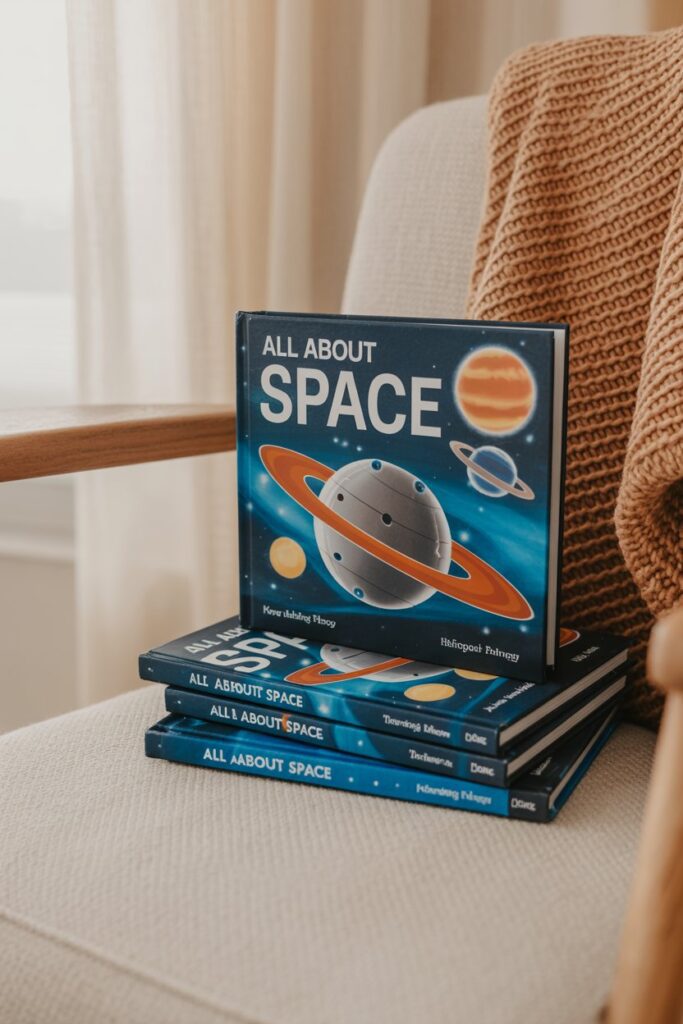
Books are often the first place kids learn that space is more than a picture in the sky — it’s a story they’re invited into. Whether you’re reading aloud at bedtime or watching your child curl up with a book on their own for the first time, space-themed books have a way of pulling kids into a world where facts feel magical and imagination feels purposeful. These titles blend science with comfort, giving kids a place to wonder, dream, and learn at their own pace.
Picture books about the moon and planets are perfect for younger readers who are still discovering how stories work. They’re gentle, beautifully illustrated, and filled with language that gives shape to big, abstract ideas. Many families find that these books become part of the bedtime rotation — the kind you end up memorizing without meaning to.
As kids grow, early reader space books help bridge the gap between being read to and reading independently. These books introduce simple vocabulary, real science facts, and short chapters that build confidence page by page.
For kids who love concrete details, nonfiction astronomy guides are a beautiful introduction to real celestial science. Think “kid-friendly encyclopedia” energy — full of star maps, moon phases, and little nuggets of information that spark dinner-table conversations. Many popular titles are available on Amazon (shop kids’ astronomy books).
Graphic novel fans will love space-themed adventure comics that weave science into storylines without losing the fun. They’re especially great for reluctant readers who connect more easily with visual storytelling.
And for kids who enjoy working things out with their hands, interactive space workbooks blend learning with doodling, tracing, and small experiments. They’re incredibly helpful during quiet-time routines, car rides, or long afternoons when kids need a focused activity that still feels playful.
For a cozy at-home moment, pair a new book with a simple themed snack — something like “moon muffins” or easy swirl treats inspired by recipes on Food Network. It turns a regular reading session into a memory.
Space-Inspired Room Décor
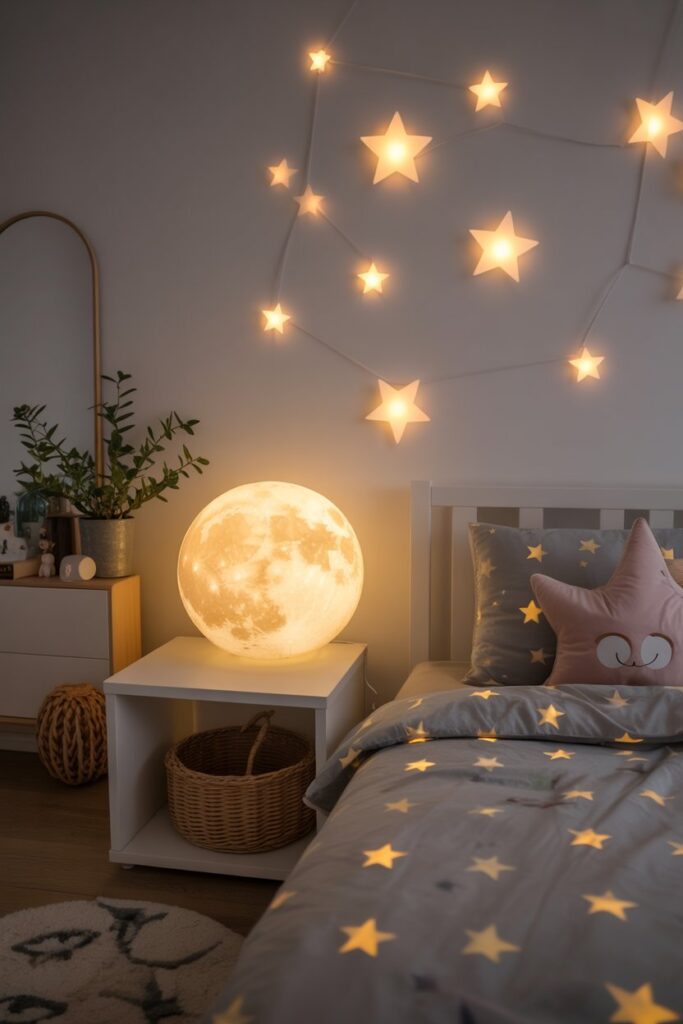
Kids spend so much of their emotional life in their rooms — dreaming, building, playing, unwinding. Space-themed décor gives them a little world that feels expansive and comforting at the same time. It’s less about creating a “theme” and more about shaping an atmosphere: one that tells your child their imagination is welcome here.
Planet mobiles are a beautiful place to start. They bring slow, gentle movement into the room — something kids instinctively respond to. Whether hung over a bed or in a reading corner, they add a sense of quiet curiosity that settles the whole space.
For an instant dose of magic, glow-in-the-dark wall decals and ceiling constellations are irresistible. These small, affordable pieces create a soft night-sky glow that makes bedtime feel less abrupt and more like easing into a dream. (Amazon: shop star decals)
If your child loves cozy textures, starry bedding sets and moon-phase blankets add warmth while tying the whole room together. These pieces often become comfort objects in their own right — the blanket they drag to the couch on Saturday mornings or wrap around themselves after school.
For kids who like a little structure in their surroundings, rocket-shaped shelves or planet wall hooks make organization feel fun instead of forced. They give kids a sense of ownership over their space, which can make a surprising difference in daily routines.
Lighting transforms everything, especially for sensitive or imaginative kids. Moon lamps, star projectors, and soft galaxy night-lights help create a nighttime routine that feels safe and soothing. Many are adjustable, letting kids choose whether they want a subtle glow or a full cosmic wash across the ceiling.
And if your child wants something understated but meaningful, framed constellation prints or minimal lunar art strike that perfect balance between kid-friendly and timeless. They grow beautifully with your child — from preschooler to preteen without ever feeling out of place.
Space Crafts + Hands-On Kits
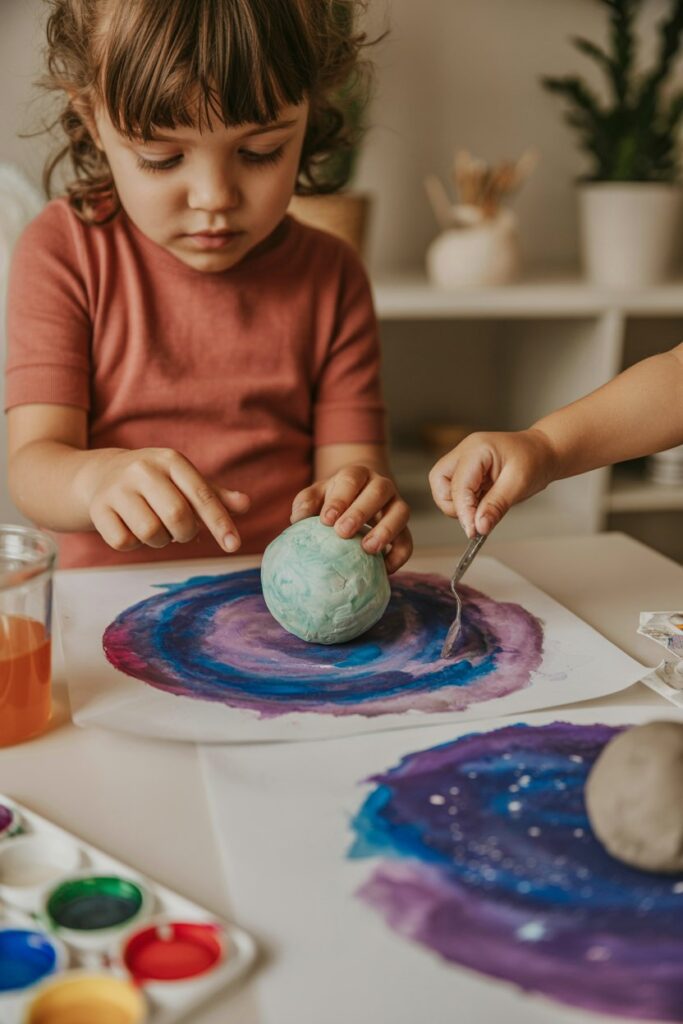
Some kids understand the world best when it’s literally in their hands. They need to mix, shape, paint, build — to turn an idea into something they can hold. Space-themed crafts give them that beautiful combination of freedom and focus, letting them explore the universe piece by piece. These projects often become the quiet moments you look back on later — the kind where time slows down and everyone breathes a little easier.
DIY clay planet kits let kids sculpt their own solar system, one wobbly sphere at a time. There’s something grounding about rolling, smoothing, and painting planets, especially for kids who process emotions through tactile play.
For budding artists, galaxy watercolor sets are pure magic. Kids get to explore color, movement, and texture in a way that mirrors the real cosmos — diffuse edges, swirling tones, everything slightly unpredictable. These projects often end up taped to bedroom doors or slipped into scrapbooks.
If your child loves repetitive, soothing work, space sticker books and constellation activity pads offer a gentle form of creative focus. They’re perfect for quiet-time routines, long car rides, or those moments when kids need something calming to do with their hands.
Families who enjoy a little experimentation will love galaxy slime kits. These kits bring the sensory joy of slime into a structured, easy-to-clean format — a small but meaningful win for both kids and parents. The glitter, the stretch, the shimmer…it’s a whole mood.
For older kids who crave a challenge, “build-your-own rocket” craft boxes hit that sweet spot between play and engineering. There’s pride in assembling a rocket from scratch, even if it’s made of cardboard or wood. The making is the memory.
If you want to tie the crafting moment into something cozy, pair it with a simple space-themed snack — maybe galaxy-themed cupcakes or swirled frosting treats inspired by recipes from Food Network. It turns an ordinary afternoon into something a little more magical.
Space Games + Puzzles

Games have this quiet way of bringing families together. They create a shared rhythm — a pause in the day when everyone gathers around the same table, cheering, thinking, imagining. Space-themed games and puzzles do something even sweeter: they connect kids to big, cosmic ideas through moments of play that feel easy and joyful.
Space-themed board games are perfect for kids who love strategy without wanting anything too serious. They introduce teamwork, cause-and-effect, and a bit of friendly competition. Many families find these games become part of their weekend rituals — a simple, grounding tradition.
For kids who like quick wins, card games inspired by planets, rockets, and star missions offer bite-sized fun. These games are easy to toss into backpacks or bring on trips, and they’re especially great for kids who thrive with fast, engaging play.
Puzzle lovers will adore galaxy and nebula puzzles. The deep colors and swirling patterns can feel almost meditative, especially for kids who use focus as a way to unwind. For families who enjoy working together, larger puzzles become tiny celebrations — everyone contributing a little piece to the final reveal. (Amazon: shop space puzzles)
Cooperative games about space missions are perfect for siblings or playgroups. Instead of competing, kids work together toward a shared goal, which can be a surprisingly powerful way to teach empathy, patience, and calm communication.
And for kids who like working quietly on their own, logic-based space puzzles — think pattern challenges, sequence-building, or “launch the rocket” brainteasers — offer a calming place for their thoughts to land. These are the gifts that help kids build confidence without pressure.
If you want to turn game night into something cozy, pair it with a fun treat like “comet popcorn,” inspired by colorful snack recipes on Taste of Home. It’s a small thing, but the vibe shift is real.
Outdoor Space Exploration Gifts

Something beautiful happens when kids step outside at night. The world gets quieter, the air cools, and suddenly the sky feels impossibly big — a place full of questions they haven’t asked yet. Outdoor space gifts help kids connect with that feeling. They turn ordinary backyards into tiny observatories and everyday moments into invitations to look up and wonder.
Constellation-spotting guides are a gentle entry point. These kid-friendly books or cards give names to the shapes kids already see, helping them understand that the sky isn’t random — it’s a story humans have been telling for thousands of years.
For kids who like tools, child-size binoculars make stargazing feel accessible. They’re light, durable, and easy to handle, giving kids a chance to notice details they couldn’t see before. (Amazon: shop binoculars)
A simple star wheel is another gift that sparks quiet curiosity. Kids love the tactile feel of rotating the disk and watching constellations shift by month — it’s hands-on learning disguised as something magical.
For families who already love spending time outdoors, beginner stargazing kits are a thoughtful upgrade. These sets often include a mini telescope, a sky map, and an easy guide. They make a backyard feel like a place of discovery instead of just a patch of grass.
If you want to make nighttime exploring even cozier, meteor-shower blankets and LED lanterns turn stargazing into a comfort ritual. Kids who struggle with transitions (bedtime, winding down, change of plans) often respond beautifully to these small sensory comforts.
And because outdoor kids often overlap with adventure lovers, this is the perfect place to link naturally to your Camping Gift Ideas for Outdoorsy Kids. Many families combine both passions easily — a galaxy blanket here, a camping chair there, and suddenly a simple evening becomes a memory-maker.
DIY Space Gifts Kids Can Make

There’s a special kind of pride kids feel when they make a gift themselves — that quiet glow that comes from seeing their work become something meaningful. DIY space gifts give kids the chance to step into that feeling. They’re part craft, part exploration, and part heartfelt offering, especially for kids who love giving just as much as creating.
Painted planet ornaments are a beautiful starting point. Kids can swirl colors, add texture, and decide which planet they’re “making.” These little globes look charming hanging from a holiday tree or displayed in a bedroom window — reminders of creativity that lasts long after the paint dries.
For families who love simple craft sessions, paper plate UFOs are surprisingly delightful. A few household supplies, some paint, a bit of foil — suddenly your child has created a whole new galaxy resident. It’s low-cost, low-pressure, and high-imagination.
Galaxy jars remain a fan favorite for a reason. Layering cotton, glitter, and dyed water creates something kids can’t stop staring at — a sensory bottle that feels soothing, mesmerizing, and proudly homemade. These also make lovely calming tools for kids who need visual grounding.
For jewelry-loving kids, solar system necklaces turn craft time into wearable art. Beads become planets, string becomes orbit, and the final result is something kids love gifting to friends, siblings, or even teachers. It’s sweet, personal, and packed with meaning.
If your child is ready for a slightly bigger challenge, LED constellation crafts introduce simple circuits in a hands-on way. Kids poke tiny holes into dark cardstock, add lights, and suddenly they’ve brought their own star map to life. It’s a project that blends creativity with early STEM in the gentlest way.
For families who love the idea of homemade gifting, this is a natural moment to link over to your DIY Holiday Gifts Kids Can Make post — especially since many of those ideas pair beautifully with these cosmic crafts.
The Ultimate Space Gift Bundles

Sometimes the most meaningful gifts aren’t a single item — they’re a thoughtful little collection that says, “I see who you are, and I love that about you.” Space gift bundles do exactly that. They gather together pieces that speak to a child’s curiosity, giving them not just a present, but a whole experience. These bundles feel intentional, personal, and full of possibility.
The “Future Astronomer” Bundle pairs a beginner telescope with a simple star map and a beautifully illustrated children’s astronomy book. It’s the kind of gift that encourages kids to step outside after dinner and look up with purpose. For many families, this becomes a quiet new ritual — one that grows with the child year after year.
The “Little Astronaut” Bundle combines a cozy NASA hoodie, a lightweight astronaut helmet, and a favorite space-themed picture book. It’s perfect for kids who live in imaginative play and want to feel fully immersed in the world they’re creating. These are the gifts kids put on immediately and don’t want to take off.
The “Galaxy Artist” Bundle is ideal for kids who create their way through life. A watercolor galaxy kit, a pack of space stickers, and a small set of metallic gel pens turn any afternoon into a quiet, dreamy art session. These bundles are magic for kids who think in colors and textures before words.
The “Junior Engineer” Bundle connects early STEM learning with the excitement of space. Pair a build-your-own rocket kit with a simple circuit-building board and a kid-friendly engineering book. This bundle gives curious minds a place to land — something to build, something to understand, and something to grow into.
The “Starry Bedroom” Bundle is a sweet option for kids who find comfort in their surroundings. A moon lamp, a set of glow-in-the-dark constellations, and a soft star-print blanket can transform their room into a space that feels both calming and full of wonder. It’s a gift that speaks directly to a child’s need for safety and imagination.
And if you want a bundle that makes a difference, you can curate an eco-friendly or ethically sourced set and link it naturally to your Socially Conscious Gifts for Kids collection. It’s a meaningful choice for families who value sustainability just as much as play.
How to Choose the Best Space Gift
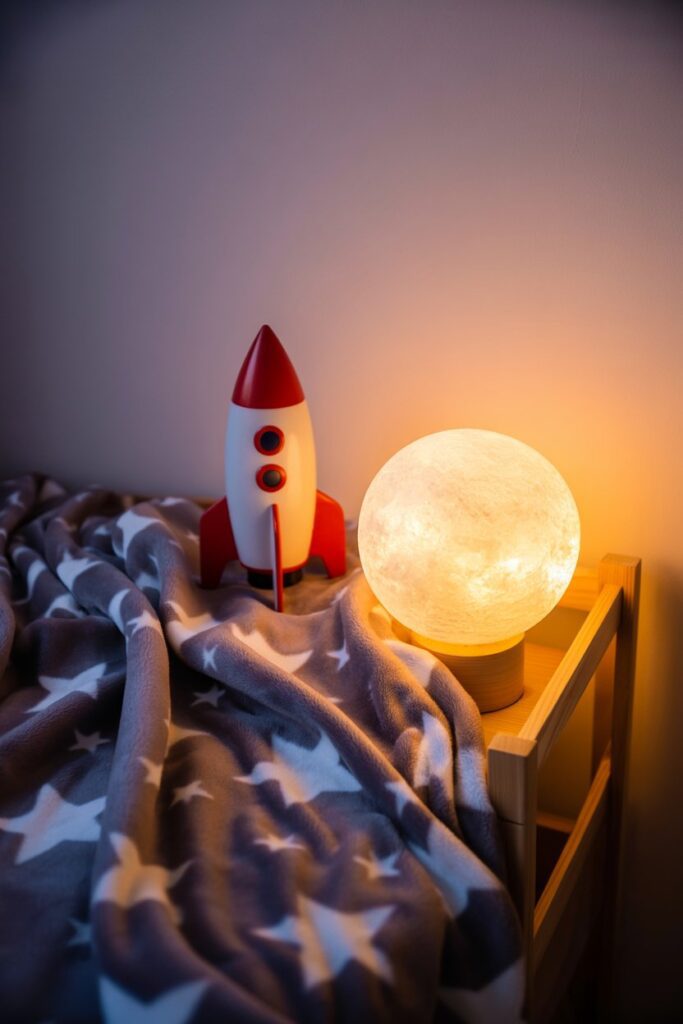
Choosing the right space gift isn’t really about finding the flashiest telescope or the biggest rocket set. It’s about noticing who your child is right now — what lights them up, what calms them, what they return to over and over again. The best gifts meet kids where they are and gently open the door to where they’re growing.
If your child is still learning through touch and movement, look for gifts with strong sensory elements: clay planet kits, glow-in-the-dark decals, soft plush planets. These items support developmental needs while still feeding their curiosity.
For kids who crave independence, STEM kits and beginner telescopes are incredibly empowering. They offer just enough challenge to feel exciting without tipping into frustration — a balance that matters more than we often realize.
Personality plays a role too. Imaginative kids thrive with dress-up pieces and dramatic-play toys that let them build worlds from scratch. More introspective kids may prefer books, journals, or quiet hobby items like puzzles, galaxy art sets, or constellation guides.
Think about your child’s daily rhythms as well. Does bedtime feel overwhelming? A moon lamp or star projector can shift that energy instantly. Do they need help winding down after school? A craft kit or calming puzzle may give their busy minds a place to soften.
And finally, don’t overlook practicality. Space backpacks, warm galaxy hoodies, and durable water bottles are gifts kids will use constantly — small daily anchors that remind them of something they love.
At the heart of it, the best space gifts are the ones that help kids feel seen. Whether your child dreams in stars, in stories, or in science, there’s something out there that fits them perfectly.
FAQ
Parents ask the best questions — the thoughtful ones that come from really knowing their kids. Here are the answers to the most common wonders about choosing the right space gifts for kids.
What are the best space gifts for toddlers?
For little ones, look for soft, simple, sensory-friendly items: plush planets, glow-in-the-dark stars, wooden rockets, and sturdy picture books. Toddlers need gifts they can explore safely and repeatedly without overwhelm.
Are telescopes worth buying for younger kids?
Yes — but start small. Beginner telescopes or kid-friendly astronomy kits help kids learn how to focus, adjust, and observe without frustration. Save the more advanced models for the tween and teen stages when attention spans and motor skills are stronger.
What age is best for rocket-building kits?
Most kids are ready for simple rocket kits around ages 7–9, when fine motor skills and patience start to sync. Older kids (10–12+) can handle more complex builds with multiple steps or light engineering concepts.
Should I get a star projector or a telescope?
It depends on your child’s personality. Projectors create a soothing, imaginative atmosphere — great for bedtime or anxious kids who love comfort. Telescopes work better for children who crave real-world observation and hands-on learning.
What’s a safe DIY space craft for preschoolers?
Galaxy jars, paper plate UFOs, and edible “moon sand” are all toddler- and preschool-friendly. They’re simple, low-risk, and satisfying for kids who learn best by touching and exploring.
Are space gifts educational or just fun?
Both — and that’s why they work so well. Space toys naturally blend open-ended play with early STEM learning. Kids learn about planets, motion, and cause-and-effect without even realizing it.
What space books are best for early readers?
Choose simple nonfiction guides with clear visuals or early chapter books with short, engaging sections. Look for editions with sturdy binding and high-contrast layouts to help new readers stay confident and focused.
How can I create a space-themed bedroom without spending a lot?
A few small pieces go a long way: glow-in-the-dark stars, a planet poster, a cozy moon pillow, or a string of star-shaped lights. These items can transform a room without a full décor overhaul.
Do teens actually want space gifts?
Surprisingly often — yes. Teens appreciate gifts that feel mature, personal, and aligned with their interests. Think wearable space apparel, room décor with a moodier aesthetic, or tech-driven tools like simple astrophotography attachments.
What’s a good space gift for kids who love being outdoors?
Binoculars, constellation guides, star wheels, meteor-shower blankets, or small stargazing kits are all wonderful. You can also cross over into adventure territory by browsing your Camping Gift Ideas for kids who thrive outside.
Final Thoughts: Raising Curious, Cosmic Kids
Kids don’t need us to teach them how to wonder — they’re already wired for it. What they need are moments and tools that help that wonder grow with them. The right space gifts for kids do exactly that. They nourish imagination, spark independence, and anchor sweet little rituals that shape childhood in quiet, lasting ways.
Whether you’re choosing a beginner telescope, a soft planet plush, a galaxy craft kit, or a room décor piece that makes bedtime gentler, every gift on this list says the same thing: I see your curiosity, and I love watching you explore. And that message stays with kids long after the wrapping paper is gone.
So take your time, trust your instincts, and choose the things that feel right for who your child is today — not who they “should” be later. Space is wide and full of possibility, and so are they.
Save this guide for later: If you want to revisit these ideas during birthdays, holidays, or those spontaneous moments when your child “suddenly” becomes obsessed with Saturn again, make sure to pin this post for easy reference.
Pin this list of 100 Best Space Gifts for Kids to Pinterest so you’ll always have cosmic inspiration close at hand.
